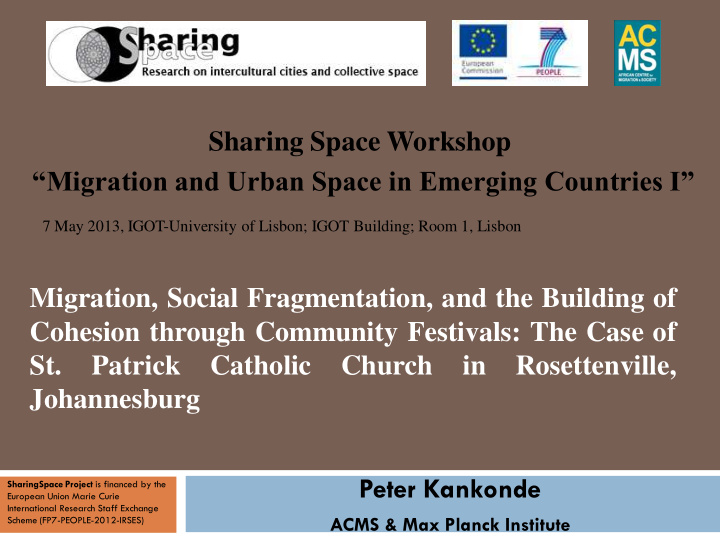



Sharing Space Workshop “Migration and Urban Space in Emerging Countries I” 7 May 2013, IGOT-University of Lisbon; IGOT Building; Room 1, Lisbon Migration, Social Fragmentation, and the Building of Cohesion through Community Festivals: The Case of St. Patrick Catholic Church in Rosettenville, Johannesburg Peter Kankonde SharingSpace Project is financed by the European Union Marie Curie International Research Staff Exchange ACMS & Max Planck Institute Scheme (FP7-PEOPLE-2012-IRSES)
Presentation Overview The Festival of All Nations Theoretical Framework: Community festival and the Contact Hypothesis Historical of Social Cohesion Issues in the Area The Festival Methodology Findings: Participants’ Perspectives Assessing the Impact: Discussion and Argument Conclusion
Object: Explore the Objectives, Analysis of the Festival’s Social Impact
Conceptual Framework: Social Cohesion Investigators interested in developing a general theory of social cohesion are confronted with a complex body of work that involves various definitions of social cohesion: membership turnover, organizational commitment, categorical identifications, interpersonal attachments, network structures), And lines of inquiry focused on the social cohesion of specific types of groups e.g., families, schools, military units, and sports teams).
Conceptual framework Cont. Social Cohesion is understood from the church leaders’ perspective as a: “Convivial family spirit and unity in diversity among our church members” (Father Gerardo, Interview 12 Dec. 2012)
Social Fragmentation, Contact Theory, and Social Cohesion Policy There is a global renaissance in community festival as a way of fostering social cohesion: Germany: e.g. The Bayreuth Africa Day Festival Australia South Africa: e.g. The Yeoville Festival
Migration History: the Ethnic and Racial Confrontational and Cohabitation Zone The City of Johannesburg has always symbolised for people from around the world, a place where people can make it easily and fast
Historical Cont. 1889-1990: For a century Greater Rosettenville was a segregated ‘whites only’ cosmopolitan Area. The Area had first housed sub economic Afrikaners and English mine workers and Eastern European Jews and Portuguese craftsmen. It latter welcomed Greeks, Lebanese, Italians, etc. Portuguese speaking population Between 1924 -1972 around 50.000 Portuguese speaking population settled in the area (from Madeira, Portugal, Mozambique and Angola). After Mozambique’s and Angola’s Independence (1975 -6), white Mozambicans moved to South Africa and many settled in Rosettenville. The Area is mainly known because of Portuguese Restaurants: the first ever Nando restaurant opened in Rosettenville in 1987.
Cont. Jewish and English emigration due to upper class mobility. These two groups withdrew quickly from mining to operate in businesses around the mines (Rubin, 2005). Over the years the Area became mainly populated by poor Portuguese and Afrikaners, although the presence of Jews and English remained noticeable. 1990-Onward: Post Apartheid invasion and succession process: most white populations leave the Area moving farther South and North, new black populations groups settle in -Black South Africans -African immigrants, from Mozambique, Angola, Zimbabwe, DRC, Nigeria among others
122 Years of In-migration for the same Motives Cheap Accommodation (Afrikaners, Jews, English and African immigrants wealth Hunters attracted by Gold rush, work opportunities, and refuge from persecution) Transportation Proximity to the City centre and place of work Family reunion and Studies
But different forms of belonging: former settled Communities Vs current transient ones Area standing (the majority of former residents moved in when the Area owned their houses. Most new residents rent rooms in a recycling process) Cultural investment and belonging Sense of belonging: Ownership and Cultural celebrations
“This is the most Interesting part of Johannesburg where you have real people” (Boet Strydon23 Oct. 2012) Turffontein Race Course Annual Spring Festival
Lusito land Festival 25 April -5 May and many Portuguese Cultural Clubs Attracts more that160,000 people Brings the tastes of Portugal to the for charity city
Wemmer Pan Musical Water Fountains Dancing Waters Public Swimming Pool
Peter Hall Museum of Land Transports and Culinary Specialities Best Recommended Portuguese The Only such Museum in SA Restaurants in JHB
Challenging Diversity Management Local Organizations experience the management of the increasing diversity of a crucial challenge for their development and social reproduction
I. Video: The Festival of All Nations Demonstrations against War Atrocities in DRC Foundation 2006 in London Violent Collective actions Global spread (Europe, America, South Africa, Asia
Qualitative Research Methods Ethnography: Participant Observation: Deep Hanging Out and Hatcher’s Guide 1. General Description of the Festival 2 3.2. Festival Setting 3. Type of Festival 4. Participation in the festival 5. Mood of the Crowd 6. Types of Objects Used in the Festival 7. Symbolism 8. Costs/Rewards for Participants and Spectators 9. Functions of the Festival (Hatcher, 1978): In-depth Interviews with member of different communities represented or not at the Festival:
Selection: Purposive and Snowball with people who have been member for at least two years 1. 5 South Africans [2 Portuguese ( male and female), 1Zulu & 1 Sotho (females) and 1 India(male)] 2. 5 Nigerians (All Igbo males) 3. 5 Zimbabweans (3 Shona & 2 Ndebele) 4. 5. Congolese (2 Luba and 2 Swahili and 1 Mungala 5. Mozambicans (1 male and 1 female), Angolans (1 male and 1 female) and Cameroonian (1 female) 5. The Priest and one church leader
Social Impact Assessment: the Factor Analysis Entertainment and socialisation opportunities (Delamere, 2001) Community growth and development Individual benefits (Delamere, 2001) Behavioural consequences (Delamere, 2001) Personal frustration and Social costs (Delamere, 2001; Fredline et al., 2003) Community identity and cohesion Community benefits (Delamere, 2001)
Preliminary Findings All interviewees found that it was a good initiative that should be continued Organized in precipitation. E.g. Mozambicans and Angolans were not represented The Festival did not have the same goal and meaning for everyone. E.g. The fund raising Vs community cohesion
Discussion The impact of community in enhancing social cohesion Can a community festival enhance cohesion in a socially transforming and fragmented areas?
. Obrigado/Thank You/Dankie/Siyabon ga/Aksanti/Twa Sakidila/Gracias
Recommend
More recommend